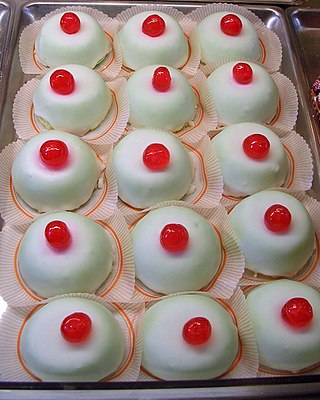Herring soup is a fish soup consisting of a thick mix of water, barley-meal and red herring.

Alan Eaton Davidson CMG was a British diplomat and writer best known for his writing and editing on food and gastronomy.

Avgolemono is a family of sauces and soups made with egg yolk and lemon juice mixed with broth, heated until they thicken.

Colcannon is a traditional Irish dish of mashed potatoes with cabbage. It is a popular dish on Saint Patrick's Day and on the feast day of St. Brigid.

Iranian cuisine is the culinary traditions of Iran. Due to the historically common usage of the term "Persia" to refer to Iran in the Western world, it is alternatively known as Persian cuisine, despite Persians being only one of a multitude of Iranian ethnic groups who have contributed to Iran's culinary traditions.

Rumford's Soup was an early effort in scientific nutrition. It was invented by Benjamin Thompson, Reichsgraf von Rumford, circa 1800 and consumed in Munich and greater Bavaria, where he was employed as an advisor to Charles Theodore, Elector of Bavaria. It was used as a ration for the poor, for Bavarian workhouses and military workhouses, and prisoners. Count Rumford has been credited in many instances for "establishing the first real soup kitchen."

Pepper Pot is a thick stew of beef tripe, vegetables, pepper and other seasonings. The soup was first made in West Africa and the Caribbean before being brought to North America through slave trade and made into a distinctively Philadelphian dish by colonial Black women during the nineteenth century.

Tarhana is a dried food ingredient, based on a fermented mixture of grain and yogurt or fermented milk, found in Central Asian, Southeast European, and Middle Eastern cuisines. Dry tarhana has a texture of coarse, uneven crumbs, and it is usually made into a thick soup with water, stock, or milk. As it is both acidic and low in moisture, the milk proteins keep for long periods. Tarhana is very similar to some kinds of kashk.

A patty is a flattened, usually round, serving of ground meat or legumes, grains, vegetables, or meat alternatives. Common ground meat used include beef, bison, elk, turkey, chicken, ostrich, and salmon. Patties are found in multiple cuisines throughout the world.

The Oxford Symposium on Food & Cookery is an annual weekend conference at which academics, food writers, cooks, and others with an interest in food and culture meet to discuss current issues in food studies and food history.

Tunisian cuisine, the cuisine of Tunisia, consists of the cooking traditions, ingredients, recipes and techniques developed in Tunisia since antiquity. It is mainly a blend of Arab, Mediterranean, Punic, and Berber cuisine. Historically, Tunisian cuisine witnessed influence and exchanges with many cultures and nations like Italians, Andalusians, French and Arabs.

Kubbeh, also known as kubbe, is a family of dishes of Iraqi Jewish, and Assyrian origin that are also popular in the Levant, and consist of a filled dumpling soup, with a wide array of fillings and soup broths. Once almost exclusively made at home by members of the Iraqi and Assyrian communities, since the early 20th century the popularity of the dish has expanded to Israelis of all backgrounds. It is commonly served in restaurants across Israel, most notably in the Machane Yehuda market in Jerusalem.

Borani is a salad dish from Iranian cuisine. It is also found in Turkish cuisine where it is associated with certain provinces like Isparta, Urfa and Van. Some versions are made with spinach and yogurt, while the Ancient Persian borani was made with eggplant, and a regional version from Urfa is made with lamb and vegetarian meatballs. Borani is also popular in the Caucasus and Afghanistan.

Qatiq is a fermented milk product from the Turkic countries. It is considered a more solid form of yogurt than ayran.

Paximathia, also spelt paximadia (plural), or paximadi/paximathi (singular), is a hard bread of Greek origin, similar to rusk, that is prepared with whole wheat, chick pea or barley flour. It has been referred to as being similar to biscotti or as a type of biscotti. Paximathia is a common food in Greece and many Greek bakeries sell the bread, which is often served as a breakfast food with marmalade or cheese. Paximathia is purveyed also in Greek specialty stores in many areas of the United States.

Sharbat is a drink prepared from fruit or flower petals. It is a sweet cordial, and usually served chilled. It can be served in concentrated form and eaten with a spoon or diluted with water to create the drink.
Ekuru is a very common native cuisine of the Yoruba people in Nigeria. It is usually prepared with peeled beans.

Cassatella di sant'Agata is a traditional Sicilian pastry from Catania made during the Festival of Saint Agatha, held from February 3rd to February 5th each year.

Seffa is a Maghrebi term for a dish of sweetened semolina cuscus with butter, cinnamon, and almonds. The dish may incorporate meat, and also alternatively be made with vermicelli or rice. This dish is generally consumed at the end of a meal, before dessert. It is often served at traditional marriage ceremonies and family gatherings.

















